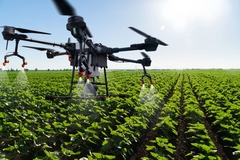US suffers a severe decline in organic farming transition since 2008, new initiative poised to reverse trend
23 Aug 2022 --- The USDA is urging the country to move into organic farming much more than it currently does with a US$300 million package designed to boost what the country dubs the “Organic Transition Initiative.” This comes after the number of non-certified organic farms actively transitioning to organic production has dropped by nearly 71% since 2008.
In a bid to reverse the major decline, the initiative will help build new markets for organics and streams of income for farmers and producers, according to the USDA.
However, the USDA is up against some concerns from farmers who believe moving into the organics space may be risky.
It aims to spread information among farming communities about transitioning to organic cultivation.

“Organic production allows producers to hold a unique position in the marketplace and thus take home a greater share of the food dollar,” states the organization.
The initiative is being led by the American Rescue Plan Funds, the USDA’s Agricultural Marketing Service (AMS), Risk Management Agency (RMA) and Natural Resources Conservation Service (NRCS).

The USDA is now setting up various systems to aid farmers and producers in executing their transition to organic farming.
A drop in active transitions to organic
The 71% decline is noted by the USDA National Agricultural Statistics Service.
The USDA is now setting up various systems to aid farmers and producers in executing their transition to organic farming.
These include technical assistance such as farmer-to-farmer mentoring, direct support through conservation financial assistance and additional crop insurance assistance, and support of market development projects in targeted markets.
“Farmers face challenging technical, cultural, and market shifts while transitioning to organic production, and even during the first years after successful organic certification,” says US agriculture secretary Tom Vilsack.
In six regions across the US, there will be partnership networks with trusted local organizations serving direct farmer training, education and outreach activities. On top of that, the USDA will connect transitioning farmers with mentors and build paid mentoring networks to share practical insights and advice.
Farmers will receive support on technical issues, workshops, field days covering organic production practices, certification, conservation planning, business development (including navigating the supply chain), regulations and marketing.
Furthermore, they will help transitioning and recently transitioned producers overcome technical, cultural, and financial shifts during and immediately following certification. USDA will provide up to US$100 million for this program.
“Through this multi-phased, multi-agency initiative, we are expanding USDA’s support of organic farmers to help them with every step of their transition as they work to become certified and secure markets for their products,” stated Vilsack.
Financial assistance to farmers
NRCS will develop a new Organic Management conservation practice standard and offer financial and technical assistance to producers who implement the practice.
The payment system for this initiative will be modeled after what is currently available to producers who follow the nutrient and pest management conservation practice standards. The USDA will fund US$75 million for this effort.
Meanwhile, the Transitional and Organic Grower Assistance Program (TOGA) is set to aid transitioning and certain certified organic producers’ participation in crop insurance, including the coverage of a portion of their insurance premium. RMA will receive $25 million in funding from the USDA for the program.
Potential concerns
Some stakeholders have shared concerns about the transition in specific markets. Due to inadequate organic processing capacity and infrastructure, a lack of certainty regarding market access and insufficient supply of certain ingredients, they argue that risks are presented.
Furthermore, the organic market focuses on a high need for additional processing and distribution. This is due to the larger organic supply chains. Some of the markets include grain, livestock, dairy, legumes, and other rotational crops.
The concerns are not baseless. As shown in June 2022, the EU’s plans to have 25% of farms be organic by 2030 fell short due to a lack of investments.
The USDA allotted US$100 million to combat potential issues in the organic supply chains pinpointed markets. The Department will seek stakeholder input on these initiatives beginning in September, resulting in an announcement of specific policy initiatives later this year.
Edited by Sabine Waldeck











